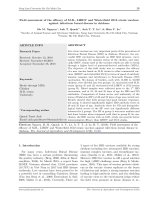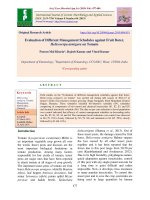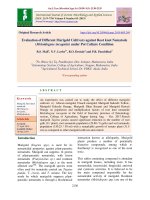Efficacy of different IPM modules against sucking pests of cucumber
Bạn đang xem bản rút gọn của tài liệu. Xem và tải ngay bản đầy đủ của tài liệu tại đây (200.9 KB, 7 trang )
Int.J.Curr.Microbiol.App.Sci (2019) 8(9): 1246-1252
International Journal of Current Microbiology and Applied Sciences
ISSN: 2319-7706 Volume 8 Number 09 (2019)
Journal homepage:
Original Research Article
/>
Efficacy of Different IPM Modules against Sucking Pests of Cucumber
S. A. Sarade, A. S. Bagde*, P. B. Mohite and V. M. Karde
Department of Entomology, R.C.S.M. College of Agriculture, Kolhapur- 416004 (MS), India
*Corresponding author
ABSTRACT
Keywords
Cucumber, Sucking
pest, Yellow sticky
trap
Article Info
Accepted:
14 August 2019
Available Online:
10 September 2019
Field experiment was conducted during Rabi season of 2017-18 with nine
modules, replicated thrice, in the ‘Randomized Block Design’ with gross
plot size 4.00 m x 3.00 m. The module M6 (7.92 aphids/plant) was found
most superior in reducing aphids population at 25, 45 and 65 days after
sowing. The next best module M4 (8.57 aphids/plant) and M5 (9.16
aphids/plant).The module M6 (5.39 jassids/plant) was found most superior
in reducing jassids population at 25, 45 and 65 days after sowing. The next
best module M4 (6.56 jassids/plant) and M5 (7.17 jassids/plant).The
module M6 (5.83 whitefly/plant) was found most superior in reducing
whitefly population at 25, 45 and 65 days after sowing. The next best
module M4 (6.68 whitefly/plant) and M5 (7.03 whitefly/plant).
with sucking pests right from primordial
stages of the crop to harvest of the products.
Introduction
Cucumber, (Cucumis sativus L.), crop is
grown worldwide and it ranks fourth in the list
of economic vegetables in Asia after tomato,
cabbage and onion. The nutritional
composition of cucumber fruit per 100 g
edible portion is water (96.30%), carbohydrate
(2.7%), protein (0.40%), Total fat (0.10%),
fiber (0.40%), mineral matter (0.4%).the fruit
is a veritable source of vitamins such as
vitamin A, C, K, E, (Vimala et al.,., 1999).
One of the major constraints not attaining
higher yields of cucurbits, as they are infested
Apart from sucking large amount of fluid from
the growing plants and debilitating the plants
aphids transmit the dreaded cucumber mosaic
virus disease as a vector in a non persistent
manner. The infected plants exhibit mosaic,
vein banding and blistering on malformed
leaves
and
fruits
thereby
reducing
marketability. Hence, present investigation
was undertaken to study the efficacy of
different ipm modules against sucking pest of
cucumber under natural infestation in the field
conditions.
1246
Int.J.Curr.Microbiol.App.Sci (2019) 8(9): 1246-1252
Materials and Methods
The field experiments were carried out with
local Kheera variety of cucumber with Nine
treatments
replicated
Thrice
in
the
‘Randomized Block Design’ with gross plot
size 4.00 m x 3.00 m during Rabi 2017-18 at
Post Graduate Research Farm, Department of
Horticulture, RCSM College of Agriculture,
Kolhapur.
Method of recording observations
Observations on sucking pest count were
recorded on five randomly selected plants in
each module plot on each selected plant, three
leaves from top, middle and bottom portion
were observed from lower side for presence of
aphids, jassids and whitefly. Pre count was
taken one day prior to spraying.
Statistical analysis
In order to compare the treatment effect based
on generated data of field experiments, the
natural
counts
were
subjected
to
transformation as per statistical methods
suggested by Panse and Sukhatme, (1967).
From the overall performance of all the
modules it was found that all the modules
were significantly superior over control in
reducing aphids population.
The module M6 (7.92 aphids/leaf) was found
as the best treatment with 40.05 per cent
reduction over control.
The next promising module was M4 (8.57
aphids/leaf), M5 (9.16 aphids/leaf) and M7
(9.24 aphids/leaf) in next order of efficacy.
The module M1 (9.75 aphids/leaf), M2 (9.85
aphids/leaf) and M8 (10.30 aphids/leaf) were
least effective.
These results are confirmative with the results
of Adhikari et al., (2013) reported that NSE
5% found most effective among NSE 2.5%
and NSE%. Rashki, et al., (2012) revealed that
the high potential of the pathogenic fungus, B.
bassiana strain DEBI008, to use in IPM
programs as an efficient biocontrol agent
against the important aphids pest, A. gossypii.
Efficacy of different modules against jassids
(Amrasca biguttula biguttula Ishida) of
cucumber
The data on counts of aphids, jassids and
whitefly were converted to square root
transformed value using square root
transformation.
Data pertaining to the survival population of
jassids on cucumber one day before and 25,45
and 65 days after sowing are presented Table
3.
Results and Discussion
From the overall performance of all the
modules it was found that all the modules
were significantly superior over control in
reducing jassids population.
Efficacy of different modules against aphids
(A. gossypii Glover) of cucumber
Data pertaining to the survival population of
aphid on cucumber one day before and 25, 45
and 65 days after sowing are presented
Table.2.
The module M6 (5.75 jassids/leaf) was found
as the best treatment with 40.66 per cent
reduction over control.
1247
Int.J.Curr.Microbiol.App.Sci (2019) 8(9): 1246-1252
Table.1 Module details for pest complex of cucumber
Sr.No.
MODULE DETAILS
M1.
Soil application of Carbofuran 10%G @ 15 Kg/ha + erection of yellow sticky traps(1-2 traps @50-100 m2)
+ foliar spray of NSE 5% + spaying of Indoxacarb 14.55%SC @ 0.5ml/L.
M2.
Soil application of Trichoderma viridae @ 3-5 Kg/ha + poison bait(Malathion 20ml + 20L water + 50g
molasses) + Metarhizium anisopliae @ 5 g/L + foliar spray of Deltametrin 1.8%EC @ 1.25ml/L.
M3.
Spaying of Pseudomonas fluorescens @ 4-6 g/L + erection of Cue lure trap + spraying of Lecanicilicium
laccani @ 5g/L + foliar spray of Propergite 57%EC @ 2ml/L.
M4.
Spraying of Spirotetramate 15%OD @ 1 ml/L + foliar spray of NSE 5% + spraying of Beauveria bassiana
@ 5g/L + spraying of Flubendamide 39.35%SC @ 0.1ml/L.
M5.
Trap crop Marigold (Two rows) + spraying of Flonicamide 50%WG @ 0.3gm/L + spraying of Metarhizium
anisopliae @ 5 g/L + foliar spray of Chloranatriniprole18.5%SC @ 0.25ml/L.
M6.
Trap crop French bean (Two rows) + spraying of Dinotefuron 20%SG @ 0.25g/L + foliar spray of NSE 5%
+ spraying of Abamectin 1.9% EC 0.5ml/L.
M7.
Trap crop Maize (Two rows) + spraying of Indoxacarb 14.55%SC @0.5ml/L + spraying of Metarhizium
anisopliae@ 5 g/L + spraying of NSE 5%.
M8.
Trap crop Mustard (Two rows) + soil application of Phorate 10%G @ 15 Kg/ha + spraying of Metarhizium
anisopliae@ 5 g/L + spraying of Acephate 75%SP @ 0.5 g/L.
M9.
Untreated control.
1248
Int.J.Curr.Microbiol.App.Sci (2019) 8(9): 1246-1252
Table.2 Efficacy of different modules against aphids on cucumber
Module
Mean survival population of
Per cent
Aphids/leaf
Reduction
Pre count
25 DAS
45 DAS
65 DAS
Mean
over control
11.04
11.13
9.02
7.81
9.75
26.19
(3.40)*
(3.41)
(3.09)
(2.88)
(3)
9.64
11.07
10.46
8.24
9.85
(3.18)
(3.40)
(3.31)
(2.96)
(3.21)
11.59
13.08
10.81
8.74
11.06
(3.48)
(3.69)
(3.36)
(3.04)
(3.40)
9.48
10.97
8.13
5.71
8.57
(3.16)
(3.39)
(2.94)
(2.49)
(3.01)
11.76
10.81
8.26
5.81
9.16
(3.50)
(3.36)
(2.96)
(2.51)
(3.10)
8.88
10.62
7.08
5.11
7.92
(3.06)
(3.33)
(2.75)
(2.37)
(2.90)
10.1
11.08
8.71
7.07
9.24
(3.26)
(3.40)
(3.03)
(2.75)
(3.12)
11.14
12.02
9.81
8.21
10.30
(3.41)
(3.54)
(3.21)
(2.95)
(3.29)
Untreated
11.3
16.21
13.81
11.51
13.21
control
(3.44)
(4.09)
(3.78)
(3.47)
(3.70)
S.E.±
NS
0.89
0.56
0.69
C.D.(5%)
NS
2.68
1.70
2.08
12.97
10.21
15.73
M1
M2
M3
M4
M5
M6
M7
M8
CV
DAS = Days after sowing
*Figures in parentheses are transformed values √X + 0.5
1249
25.44
16.28
35.12
30.66
40.05
30.05
22.02
-
Int.J.Curr.Microbiol.App.Sci (2019) 8(9): 1246-1252
Table.3 Efficacy of different modules against jassids on cucumber
Module
Mean survival population of
Per cent
jassids/leaf
Reduction
Pre count
25 DAS
45 DAS
65 DAS
Mean
over control
10.16
9.08
6.75
5.07
7.77
19.81
(3.26)*
(3.10)
(2.69)
(2.36)
(2.87)
9.21
8.36
7.26
6.66
7.87
(3.12)
(2.98)
(2.79)
(2.68)
(2.90)
9.84
10.31
8.91
5.11
8.54
(3.22)
(3.29)
(3.07)
(2.37)
(3.01)
7.71
7.61
6.36
3.11
6.20
(2.87)
(2.85)
(2.62)
(1.90)
(2.59)
8.08
7.81
6.97
5.81
7.17
(2.93)
(2.88)
(2.73)
(2.51)
(2.77)
8.66
6.51
3.26
4.56
5.75
(3.03)
(2.65)
(1.94)
(2.25)
(2.50)
8.79
8.01
7.02
6.26
7.52
(3.05)
(2.92)
(2.74)
(2.60)
(2.83)
9.64
8.97
7.46
6.51
8.15
(3.18)
(3.08)
(2.82)
(2.65)
(2.94)
Untreated
10.43
10.51
9.36
8.46
9.69
control
(3.31)
(3.31)
(3.14)
(2.99)
(3.19)
S.E.±
NS
0.74
0.49
0.71
C.D.(5%)
NS
2.22
1.48
2.15
14.87
12.14
21.60
M1
M2
M3
M4
M5
M6
M7
M8
CV
DAS = Days after sowing
*Figures in parentheses are transformed values √X + 0.5
1250
18.78
11.87
36.02
26.01
40.66
22.39
15.89
Int.J.Curr.Microbiol.App.Sci (2019) 8(9): 1246-1252
Table.4 Efficacy of different modules against whitefly on cucumber
Module
Mean survival population of
Per cent
whitefly/leaf
Reduction
Pre count
25 DAS
45 DAS
65 DAS
Mean
over control
8.57
8.41
8.01
6.11
7.78
19.96
(3.01)*
(2.98)
(2.92)
(2.57)
(2.88)
9.44
9.81
7.86
6.02
8.28
(3.15)
(3.21)
(2.89)
(2.55)
(2.96)
9.84
10.11
9.08
7.98
9.25
(3.22)
(3.26)
(3.10))
(2.91)
(3.12)
8.16
7.61
6.11
4.85
6.68
(2.94)
(2.85)
(2.57)
(2.31)
(2.68)
8.86
7.26
6.18
5.81
7.03
(3.06)
(2.79)
(2.58)
(2.51)
(2.74)
7.86
6.14
5.08
4.24
5.83
(2.89)
(2.58)
(2.36)
(2.18)
(2.52)
8.11
7.97
6.86
6.41
7.34
(2.93)
(2.91)
(2.71)
(2.63)
(2.80)
9.51
9.02
7.96
6.86
8.34
(3.16)
(3.09)
(2.91)
(2.71)
(2.97)
Untreated
10.81
10.51
9.36
8.18
9.72
control
(3.36)
(3.32)
(3.14)
(2.95)
(3.20)
S.E.±
NS
0.43
0.86
0.51
C.D.(5%)
NS
1.31
2.59
1.53
8.81
20.14
14.00
M1
M2
M3
M4
M5
M6
M7
M8
CV
9.26
4.83
31.28
27.67
40.02
24 49
14.20
-
DAS = Days after sowing
*Figures in parentheses are transformed values √X + 0.5
The next promising module was M4 (6.20
jassids/leaf), M5 (7.17 jassids/leaf) and M7
(7.52 jassids/leaf) in next order of efficacy.
The module M1 (7.77 jassids/leaf)and M2
(7.87 jassids/leaf)were least effective. Naved
Sabir et al.,.,(2011) reported that combination
1251
Int.J.Curr.Microbiol.App.Sci (2019) 8(9): 1246-1252
of azadirachtin and agrospray (0.5%) was the
most effective component of IPM for
controlling the sucking pests of cucumber
under protected cultivation. Of the potential
biological control agents tested in this study.
Efficacy of different modules against
whitefly (Bemisia tabaci Gen.) of cucumber
Data pertaining to the survival population of
whitefly on cucumber one day before and 25,
45 and 65 days after sowing are presented
Table 4. From the overall performance of all
the modules it was found that all the modules
were significantly superior over control in
reducing whiteflies population. The module
M6 (5.83 whitefly/leaf) was found as the best
treatment with 40.02 per cent reduction over
control. The next promising module was M4
(6.68 whitefly/leaf), M5 (7.03 whitefly/leaf)
and M7 (7.34 whitefly/leaf) in next order of
efficacy. The module M1 (7.78 whitefly/leaf)
was least effective.
These results are confirmative Naved Sabir et
al.,., (2011) reported that combination of
azadirachtin and agrospray (0.5%) was the
most effective component of IPM for
controlling the sucking pests of cucumber
under protected cultivation. Of the potential
biological control agents tested in this study.
Banshiwal et al.,., (2018) reported that all
among the treatments, acetamiprid 20 SP
found most effective against whitefly as
recorded 62.79 per cent population reduction.
References
kernel extract against aphids (Aphis
gossypii) and jassids (Amarasca
biguttula) on brinjal. Pestology vol.
37: 23-26.
Banshiwal, R., N. L. Dangi, M. K. Mahla and
Kuldeep Kumar.2018.Bio-efficacy of
various insecticides against insect pests
of cucumber (Cucumis sativus L.)
under protected cultivation. Journal of
Pharmacognosy and Phytochemistry
2018; 7 (6): 389-392 E-ISSN: 22784136 P-ISSN: 2349-8234 JPP 2018;
7(6): 389-392.
Naved, Sabir, Sikha Deka, Balraj Singh, R.
Sumitha, Murtaza Hasan, Mukul
Kumar, R. K. Tanwar and O. M.
Bambawale.2011. Integrated pest
management
for
greenhouse
cucumber: A validation under north
Indian plains. Indian J. Hort. 68(3),
357-363.
Panse, V. G. and Sukhatme, P. V. 1967.
Statistical Method for Agricultural
Workers. Second edition. Indian
Council of Agricultural Research. New
Delhi, 38 1p.
Rashki, Asghar Shirvani.2012. The effect of
entomopathogenic fungus, Beauveria
bassiana on life table parameters and
behavioural response of Aphis gossypii
Maryam. Bulletin of Insectology 66(1):
85-91, 2013 ISSN 1721-8861.
Vimala, P., Ting C.C., Salbiah H., Ibrahim B
and Ismail L. 1999. Biomass
production and nutrient yields of four
green manures and theur effects on the
yield of cucumber. J. Trop. Agric. And
Food Sci., 27:47-55.
Adhikari, M. M., Jha, S., Mondal S., Adhikari,
Mayukt. 2013. Efficacy of neem seed
How to cite this article:
Sarade, S. A., A. S. Bagde, P. B. Mohite and Karde, V. M. 2019. Efficacy of Different IPM
Modules Against Sucking Pests of Cucumber. Int.J.Curr.Microbiol.App.Sci. 8(09): 1246-1252.
doi: />
1252









